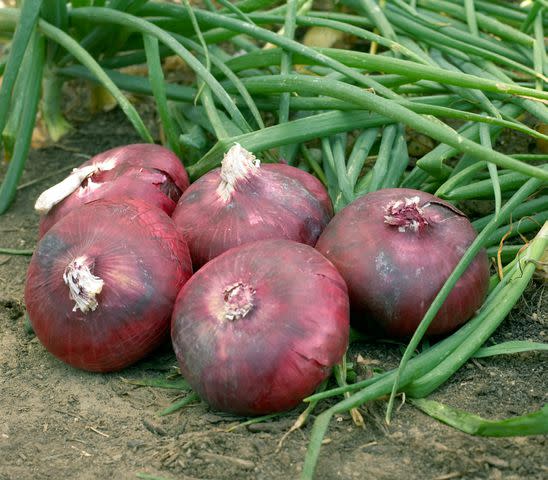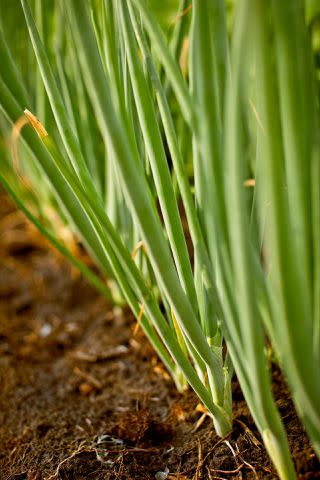How To Grow Onions for Adding Fabulous Flavor to All Your Recipes
You don't need much space to grow this popular vegetable.
Onions are the third most popular fresh vegetable in the United States; the average American eats about 20 pounds of them per year, according to the National Onion Association. And, no wonder! Without them, your favorite stir-fries, hearty soups, sandwiches, and salads just wouldn't be the same. That savory flavor seems even more delicious when using homegrown onions. Growing these aromatic bulbs isn't too difficult and they don't need much space. But, if you're new to vegetable gardening or you've never tried raising this particular crop before, there are a few essentials to know about how to grow onions. The following tips will give you the keys to a successful experience, such as the best time to plant them, how much sun onions need, and when to harvest them.

<strong>When to Plant Onions</strong>
About 2-3 weeks before the average last frost date for your area is the best time to plant onions outdoors. Exactly when to plant them depends on how soon you can work the ground in spring. Onions, which are a cool-season vegetable, can survive light frost but it's best to wait until your low temperatures stay above 28°F. In warmer regions, onions can be planted in the fall, at least a month before cool weather arrives so they have time to grow some roots. Then, they'll go dormant over the winter, and finish growing in the spring when the weather warms up again.
How to Plant Onions
You can either start with seeds or you can buy sets, which are tiny onion bulbs. Many gardeners find it easier to work with sets than the small seeds. You'll get a harvestable crop a little sooner from sets, too. However, a packet of seeds is typically cheaper to buy than a similar number of sets. Whichever one you go with, make sure to plant your onions in well-drained soil and full sun.
How to Plant Onion Seeds
When planting onions from seeds, you have two options. Start them indoors 6-8 weeks before you would plant them outside, then transplant them to the garden; or you can sow seeds directly in the ground in early spring. If you have a short growing season, you may want to start them indoors to ensure your onions have at least 3 months of cool weather conditions to develop. Either way, cover seeds with a quarter inch of soil. Sow 2-5 seeds per inch in a row, then thin them out as they grow (you can throw the thinned seedlings into a salad to add a mild onion flavor). If you are growing onions to a large size, thin them so they are 3-4 inches apart. For green onions, they can be spaced about an inch apart. Keep the soil consistently moist when the green tops are actively growing.
How to Plant Onion Sets
If you want to grow large onions, it's best to start with sets ($9, The Home Depot). If you're growing sets into scallions or green onions, plant the bulbs 1½ to 2 inches deep and 1 inch apart with the pointed end up. If you're growing large onions, plant the bulbs ½ inch deep and 4 inches apart. You can also grow them in containers that are at least 16 inches wide and 12 inches deep. Containers or raised beds are a good option for growing onions if you have soil that doesn't drain well.

How to Grow Onions
Onions do best in nutrient-rich, loose, well-drained soil. Adding a generous amount of compost to your planting area before installing your onions will help with all 3 of those soil qualities. If you have heavy clay or rocky soil, raised beds or large containers are the way to go. Onions require a steady supply of nutrients as they grow, so at planting, add a balanced vegetable garden fertilizer ($13, The Home Depot) to the soil to encourage root growth. After about 3 weeks of growth, you'll want to boost nitrogen to fuel the green tops; a sprinkling of blood meal ($7, Lowe's) around the plants every other week works well. Otherwise, keep your onions well watered and weeded throughout the growing season until your onions reach the size you want.
:A Beginner Vegetable Gardener's Guide to Creating a Productive Growing Space
How Do Onions Grow?
Onions grow their roots and leaves when temperatures are still on the cool side, 55 to 75°F. When bulbs start to form, however, the plants need warm temperatures and prefer low humidity. If there are a lot of cool, overcast days as the bulbs develop, their growth stalls. If your plants get stressed from drought, they may bolt, which means they'll produce a flower stalk. Once an onion bolts, the bulb won't store well, but you can still pull it up and eat it right away, either fresh or cooked in a recipe.
When it comes to how much sun onions need, some varieties require more daylight than others. Long-day onions such as yellow 'Stuttgarter' ($14, Etsy) stop growing their green tops and start forming bulbs when they receive 14 to 16 hours of light per day, making them a great choice for Hardiness Zone 5 and colder. Short-day onions such as 'Texas Early Grano' form bulbs when days contain 10 to 12 hours of sunlight, so they're a good choice for planting in the spring and fall in the lower third of the United States.
How Long Do Onions Take to Grow?
Long-day onions take about five months to grow from seed. Northern gardeners who want to grow onions from seed should consider growing short-day varieties or green onions.
When to Pick Onions
You can use green onions and scallions right from the garden. For storage-type onions, wait until the green tops begin to turn yellow and tip over. Then, gently pull up the bulbs and let them cure in the sun (or a warm, dry, sheltered space such as a garage if rain is in the forecast) for a week. This curing step helps the onions keep longer. Once they have completely dried, trim off the roots and cut the leaves about an inch from the bulb. Store your onions in a cool place (but not the fridge) until you are ready to use them.
:How Herb Gardening Can Save Home Cooks a Ton of Money
Once you've experienced how to easy it is to grow onions yourself, you can use them in all your favorite recipes. Try caramelizing onions or grilling them for a homemade burger topper. Use your green onions in a creamy dip for other veggies from the garden. No matter how you choose to eat them, you'll love being able to enjoy all the fresh, homegrown onions right from the yard.
false
